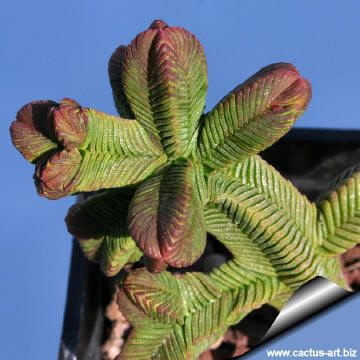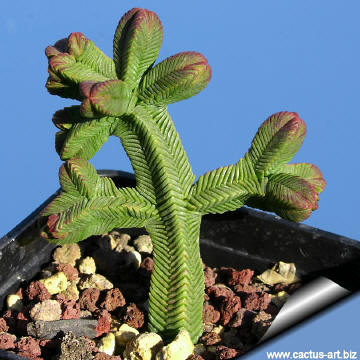|
|
|

C. pyramidalis has Interesting “leaves” that
are pressed tightly against the stem forming a quadrangular column.
Makes unusual micro mini indoor Bonsai or houseplant.
|
|
 |
 |
|
It is a
little plant oddity which is so appealing. It forms little and perfect
square stemmed columns. |
|
|
|


Advertising
|
|
|
|
|
Family: Crassulaceae
Scientific Name: Crassula
pyramidalis Thunb.
In:
Nova Acta
Phys.-Med. Acad. Caes. Leop.-Carol. Nat. Cur. 6:329, 336, t. 5b, fig. 3.
1778
Origin: South Africa (Little Karoo, Namaqualand)
Habitat: Found in the succulent Karoo, on coastal plains, dry
Fynbos and hill-tops on quartzitic sand stone, either in summer or
winter rainfall areas.
Common names: Pagoda Mini Jade
Synonyms:
- Tetraphyle
quadrangula Eckl. & Zeyh.
- Purgosea pyramidalis
(Thunb.) G.Don
- Crassula quadrangula
(Eckl. & Zeyh.) Endl. & Walp.
- Crassula pyramidalis
Thunb. var. ramosa Schönland
- Tetraphyle
pyramidalis (Thunb.) Eckl. & Zeyh.
Etymology: From the Latin adjective "pyramidalis",
"pyramid-shaped" referring to the square-shaped and
tapering body of the plant. Crassula is a very large genus. In general, only the
South African species are of interest to the collectors.
The flowers are usually
described as inconspicuous, but when accorded favourable conditions as
to sunlight and a free air circulation they are pretty nice.
|
|
|
|
Description:
Small sparingly clustering succulent or small shrub, up to
10(-25) cm tall, 20-50 mm in diameter with numerous closely imbricated
leaves, surmounted by a tuft of white flowers. It is pretty slow
growing.
Stem: Erect to decumbent, dichotomously branching which topples
over with age, but variable in size.
Roots: Fibrous.
Leaves: Small (4-8 mm across), ascending, equal-sized, extremely
thin, flat, triangular-ovate, bright green to brownish-green that are
firm and closely stacked on top of each other forming a perfect
minaret-shaped quadrangular column about 12 mm in diameter, tappering at
the obtuse tip. Margins entire. , tip bluntly acute. In full sun sun the
apical leaves can take a nice purple tinge.
Flowers: Small sweet-scented white to cream-pink appearing in a
dens terminal cluster (cymose capitula) the basal part partly hidden by
the leaves. Sepals up to 5 mm long oblong-lanceolate, margin ciliate,
tip obtuse. Calyx tubular ampulliform, about 12-14 mm long. Lobes white
to cream, oblong-elliptic, fused in the flowers tips with a blunt beak.
Anthers yellow. Bud reddish.
Blooming season: Mid spring to summer, unfortunately plants die
after blooming.
|
|
Cultivation:
Outdoors in frost free areas, indoors all other zones. Easy to grow
needs moderate water – not too wet nor too dry from autumn to spring
with regular water in summer (careful watering required in winter),
fairly drought tolerant elsewhere. Plants grow well in a well-drained
mineral soil.
Cannot take direct sun in summer but generally needs sun part of the day
to bloom. In deep shade it gets
pretty weak and leggy and eventually rots and dies. Crassulas are sensitive to mealybugs. Protect against frost.
After growing for several years
tend to
become untidy, and should be cut very short or restarted from cuttings.
Propagation: Seeds/
Stem
cuttings. Sow seeds in autumn. Plants root easily from
cuttings, place cuttings in clean river sand, mist every three to four
days, roots should appear with 2-3 weeks. |
|